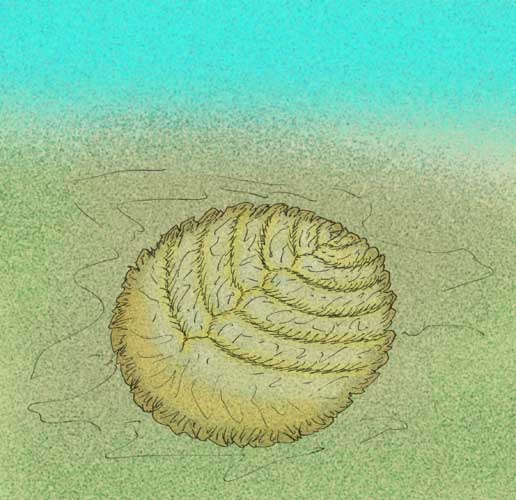Vendiamorpha on:
[Wikipedia]
[Google]
[Amazon]
Vendiamorpha
is a
 The phenomenon of left-right alternating segments is called ''
The phenomenon of left-right alternating segments is called ''
class
Class or The Class may refer to:
Common uses not otherwise categorized
* Class (biology), a taxonomic rank
* Class (knowledge representation), a collection of individuals or objects
* Class (philosophy), an analytical concept used differentl ...
of extinct animals within the Ediacaran phylum Proarticulata
Proarticulata is a proposed phylum of extinct, bilaterally symmetrical animals known from fossils found in the Ediacaran (Vendian) marine deposits, and dates to approximately . The name comes from the Greek () = "before" and Articulata, i.e. ...
.
The typical vendiamorph had an oval-shaped or round-shaped body divided completely into segmented isomers
In chemistry, isomers are molecules or polyatomic ions with identical molecular formulae – that is, same number of atoms of each element – but distinct arrangements of atoms in space. Isomerism is existence or possibility of isomers.
...
, that were arranged alternately in two rows with reference to the longitudinal axis of the body.
Description
 The phenomenon of left-right alternating segments is called ''
The phenomenon of left-right alternating segments is called ''glide reflection
In 2-dimensional geometry, a glide reflection (or transflection) is a symmetry operation that consists of a reflection over a line and then translation along that line, combined into a single operation. The intermediate step between reflection ...
symmetry'', and is a diagnostic feature of proarticulata
Proarticulata is a proposed phylum of extinct, bilaterally symmetrical animals known from fossils found in the Ediacaran (Vendian) marine deposits, and dates to approximately . The name comes from the Greek () = "before" and Articulata, i.e. ...
ns. Transverse elements decrease in size from one end to the other and are inclined in the same direction. The larger isomers cover the smaller ones externally and the first isomer is much larger than the rest.
Typically, the first few, or largest isomers are fused together to form a headshield-like structure, leading some researchers to have originally considered them to be ancestral or related to arthropod
Arthropods (, (gen. ποδός)) are invertebrate animals with an exoskeleton, a segmented body, and paired jointed appendages. Arthropods form the phylum Arthropoda. They are distinguished by their jointed limbs and cuticle made of chiti ...
s,
though, overwhelming evidence of them being proarticulata
Proarticulata is a proposed phylum of extinct, bilaterally symmetrical animals known from fossils found in the Ediacaran (Vendian) marine deposits, and dates to approximately . The name comes from the Greek () = "before" and Articulata, i.e. ...
ns have since led researchers to discard this hypothetical relationship.
Some vendiamorphs (e.g., ''Vendia'' and ''Paravendia'') supposedly demonstrate a digestive-distributive system consisting of a simple axial tube and lateral appendages, with one lateral appendage corresponding to one isomer.
Class Vendiamorpha currently includes only one Family
Family (from la, familia) is a group of people related either by consanguinity (by recognized birth) or affinity (by marriage or other relationship). The purpose of the family is to maintain the well-being of its members and of society. Idea ...
Vendiidae (originally referred to as Vendomiidae as the type genus
In biological taxonomy, the type genus is the genus which defines a biological family and the root of the family name.
Zoological nomenclature
According to the International Code of Zoological Nomenclature, "The name-bearing type of a nominal ...
''Vendomia'',
before ''V. menneri'' was redescribed as a member of '' Dickinsonia''
) that consist of species ''Vendia sokolovi'', ''V. rachiata'', ''Paravendia janae'' and possibly ''Karakhtia nessovi'', from Ediacaran (Vendian) rocks of the Arkhangelsk Region
Arkhangelsk Oblast (russian: Арха́нгельская о́бласть, ''Arkhangelskaya oblast'') is a federal subject of Russia (an oblast). It includes the Arctic archipelagos of Franz Josef Land and Novaya Zemlya, as well as the Solovet ...
in Russia
Russia (, , ), or the Russian Federation, is a transcontinental country spanning Eastern Europe and Northern Asia. It is the largest country in the world, with its internationally recognised territory covering , and encompassing one-eig ...
.
Name
The clade name ''Pseudovendia
The "ivesheadiomorphs" are a group of fossilised structures known from Ediacaran localities in England and Newfoundland. They are considered to be taphomorphs, representing the poorly preserved biological remains of various contemporary taxa suc ...
'' refers to the resemblances to a fossil imprint described as ''Vendia sokolovi''. Originally, that fossil was interpreted as an arthropod,
later as a proarticulata
Proarticulata is a proposed phylum of extinct, bilaterally symmetrical animals known from fossils found in the Ediacaran (Vendian) marine deposits, and dates to approximately . The name comes from the Greek () = "before" and Articulata, i.e. ...
n, then conjectured as possibly a frond-like organism.
Current scientific consensus now recognizes the poorly preserved holotype of ''Pseudovendia'' as a pseudofossil
Pseudofossils are inorganic objects, markings, or impressions that might be mistaken for fossils. Pseudofossils may be misleading, as some types of mineral deposits can mimic lifeforms by forming what appear to be highly detailed or organized str ...
.
See also
*List of Ediacaran genera
This is a list of all described Ediacaran genera, including the Ediacaran biota. It contains 227 genera.
References
{{reflist, 30em
*
Ediacaran
The Ediacaran Period ( ) is a geological period that spans 96 million years from the end ...
References
External links
* {{Ediacaran-stub Prehistoric animal classes